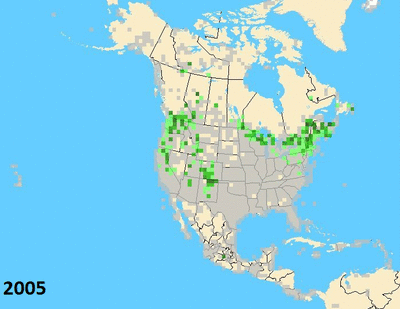 |
| Evening Grosbeaks I photographed at the home of Boise birder Danette Henderson |
Over the last two years, I seem to have noticed an increase in reports of Evening Grosbeaks on Idaho and Utah birding listservs, which got me to wonderin', "Are they really back?"
I figured that eBird sightings maps would show me if Evening Grosbeaks were gaining some traction in recent years, so I made another animated map...
eBird Sightings Map of the Evening Grosbeak from 2005 to Today!
It is mentioned in several places online that Evening Grosbeaks tend to follow a two-year irruptive cycle. That appears to be fairly accurate from these maps, but in 2010 it appears that we had a particularly strong year within its typical range. Idaho certainly did experience a strengthening of Evening Grosbeak sightings over the last couple of years. (The caveat being that eBird use in Idaho has been growing in recent years too.)
I needed some background on the historical range of the Evening Grosbeak. Birds of North America Online and Project FeederWatch are helpful for this kind of information. The Great Backyard Bird Count website also has an animated map which is pretty cool. The Evening Grosbeak was once a western North American bird only, but expanded it range eastward across Canada starting in the late 1800's. Some assume that the planting of box elder trees that Evening Grosbeaks feed on through the winter, along with outbreaks of certain insects helped fuel that eastward expansion. Was this eastern expansion really man-caused or was it a natural part of the Evening Grosbeak evolution?
Over the last couple of decades, numbers of Evening Grosbeaks plummeted. What was the cause of the decline? Is the Evening Grosbeak a historical maniac, with cyclical high highs and low lows? or was the decline man-caused?
 Based on the eBird sightings maps, it appears that since 2007 they are starting to rebound...but again, eBird use was also on the rise during these years. Not many sightings in the last few years are reported across the entire range as shown in the range map to the left.
Based on the eBird sightings maps, it appears that since 2007 they are starting to rebound...but again, eBird use was also on the rise during these years. Not many sightings in the last few years are reported across the entire range as shown in the range map to the left.I guess I leave you and myself with more questions than answers. Please continue reporting your sightings of Evening Grosbeaks to eBird so we call can learn and watch together and modify our behavior toward their habitat if needed.
As for me, I hope that such a cool and handsome bird comes back so strong that I can show my grandkids with a twinkle in my eye that "they are everywhere!"



Great photo and post! We haven't had any around here since winter.
ReplyDeleteI really hope there will be a stable community of these wonderful birds. Great photo there,friend!
ReplyDelete@MaineBirder - Thanks for taking the time to leave a nice comment! I haven't had an Evening Grosbeak to my feeder yet, but I am hopeful still!
ReplyDelete@Amila - I guess your comment hits my main question...do Evening Grosbeaks ever have a "Stable" population?
Interesting post and map! I remember back in the early 80s I had large groups visiting my feeder in Springfield, MA. At that time I didn't realize what a rarity they would be come. Now I see maybe 2 or 3 in my yard a couple of times a year and I am always surprised, and delighted, when they appear.
ReplyDelete@Hilke - Thanks for sharing your experience with Evening Grosbeaks. They are such a cool bird. I hope you and every reader of Birding is Fun! will use eBird to help track all their bird sightings.
ReplyDeleteAt a friend's place in North Idaho yesterday. At one point there were 10 males at their feeder and several females.
ReplyDeleteWe live in eastern Washington state. last year i think i saw several pass through but this year we have many many breeding pairs all around us!! This has never occured here that anyone is aware of, in this canyon. They REALLY REALLY like black sunflower seed! i am guessing 50-75 birds are living around us in maple trees.
ReplyDelete